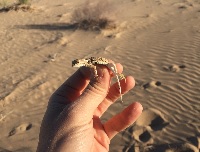Yuman Desert Fringe-Toed Lizard (Uma rufopunctata)
Description: The Yuman Desert Fringe-toed Lizard is a medium sized lizard with a flat body and a fragile tail. As a result of growth, the lizard grows in size ranging from 0 to 5cm as juveniles and 7 to.12.2cm for adults in total length. The body parts consists of a pointed snout for easy burrowing, moderately large eyes with interlocking eyelids, a countersunk lower jaw, flaps over the ear openings and valves in the nasal passages. It has small, harsh and granular scales. Usually, they are cream, tan and reddish-brown in colour but specifically, cream in the underside with blatant dark spots on the belly sides as well as on the throat. The unique orange coloration on the belly during breeding season as well as the dark lines on the neck and shoulders distinguish this lizard from the similar species. The dorsal side is marked with small orange spots and on the neck through to the shoulder, the spots form lines and eventually appear in rows. The scales on the back edges of the toes are special and pointed, looking like a fringe hence, the name by which it is called.
Habitat: This species is restricted to sparsely vegetated windblown sand dunes and sandy flats; it requires fine, loose sand for burrowing; vegetation is usually scant, consisting of creosote bush or other scrubby growth (Stebbins 2003). Eggs are laid below the surface in sand. It has been found in relatively degraded habitats where there is soft sand.
Range: This species is restricted to the Yuma Desert, where it is found in a small coastal portion of the Mexican state of Sonora. The hybrid between it and U. notata ("Uma rufopunctata") ranges further north through Sonora into southern Arizona. The Reptile Database erroneously lists it as endemic to Arizona.
Found in these States:
AZ
Diet: Eats chiefly insects, but occasionally other lizards and buds, leaves, and flowers.
Reproduction: Lays clutches of 1-5 eggs (average of 2), probably every 4-6 weeks from May to August.
Status: Listed as Near Threatened since the species depends on areas of wind-blown sand, and so its area of occupancy is probably not much greater than 2,000 kmē, and the extent and quality of its habitat is declining, thus making the species close to qualifying for Vulnerable under criterion B2ab(iii).
Taxonomy: This species has a confusing taxonomic history. Previously, it was referred to as Uma rufopunctata, and was defined as ranging from the vicinity of Yuma, Arizona south to the Gran Desierto de Altar, and southeast from here through Puerto Penasco south to the Tepoca Bay. In 1941, Heifetz described Uma notata cowlesi as a new subspecies of the Colorado Desert fringe-toed lizard (Uma notata), and synonymized Uma rufopunctata with Uma notata; however, the name Uma rufopunctata was kept for this species by later sources. Finally in 2016, Gottscho et al. found Cope's rufopunctata to in fact represent a hybrid population between Uma notata and Uma cowlesi, and thus only recognized notata and cowlesi as distinct species.
»» Kingdom: Animalia - Animals
»» Phylum: Chordata - Chordates
»» Subphylum: Vertebrata - Vertebrates
»» Class: Reptilia - Reptiles
»» Order: Squamata - Lizards
»» Family: Phrynosomatidae - North American Spiny Lizards
»» Genus: Uma
»» Species: Uma rufopunctata - Yuman Desert Fringe-Toed Lizard
»» Subspecies: None
This article uses material from the Wikipedia article "Yuman Desert Fringe-Toed Lizard", which is released under the Creative Commons Attribution-Share-Alike License 3.0. Content may have been omitted from the original, but no content has been changed or extended.
|








